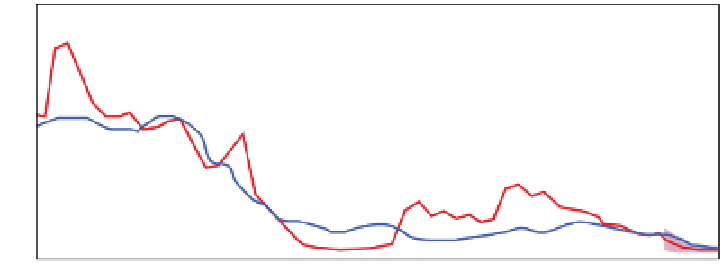Geoscience Reference
In-Depth Information
(A)
anoxia
300
250
200
150
100
50
1
Others/Unknown
Bryozoans
Bivalves
Corals
Sponges
Calc. algae
Microbes
0.5
hyper-
calcifiers
(B)
0
Cm
O
S
D
C
P
Tr
J
K
Pg
N
?
glaciation
7000
?
COPSE
6000
5000
4000
3000
2000
1000
GEOCARB III
?
(C)
?
0
Palaeozoic
Mesozoic
Cenozoic
500
400
300
200
100
0
Time (Myr)
Figure 4.1
Phanerozoic distribution of reefs, reef builders, and environmental variables. A: Reef abundance through time, with intervals of widespread
subsurface anoxia in yellow. B: Proportional contribution of reef-building organisms to total reef mass as a function of time.The data are coloured to highlight
the comings and going of hypercalcifying taxa (in red). C: Atmospheric p CO
2
estimates and intervals marked by continental ice sheets, as inferred from geological
observations, geochemical data, and numerical models. Initials indicate the periods of the Phanerozoic Eon: Cm, Cambrian; O, Ordovician; S, Silurian;
D, Devonian; C, Carboniferous; P, Permian; Tr, Triassic; J, Jurassic; K, Cretaceous; Pg, Palaeogene; N, Neogene. Data in A and B are from Kiessling ( 2009 ).
ratios of boron) come with their own interpretational
challenges (e.g. Royer
et al
. 2001 ), but generally sup-
port model-based hypotheses for Phanerozoic envi-
ronmental history.
The amount of CO
2
in the atmosphere has
clearly varied through geological time, and was
often considerably higher than values seen in the
atmosphere today. However, when considered
alone, estimates of past atmospheric
p
CO
2
do a
poor job in predicting the evolutionary history of
skeletal biotas (Fig. 4.1). For example, during the
Cambrian and Ordovician periods, when
p
CO
2
was at its Phanerozoic maximum, skeletal biotas
were radiating throughout the oceans (e.g. Knoll
2003 ). Clearly, then,
p
CO
2
is not, in and of itself, a
parameter that tracks the evolution of hypercalci-
i ers. To understand the history of biomineraliza-
tion, we must place it in the broader context of the
expected behaviour of the l uid earth carbonate
system as a whole.
Over long timescales (
³
10 000 yr) the marine car-
bonate system operates in a dynamic equilibrium
due to feedbacks among fundamental processes
operating in the carbon cycle. The carbonate system
has six parameters, but because of interdepend-
ences can be reduced to two dimensions (see


































